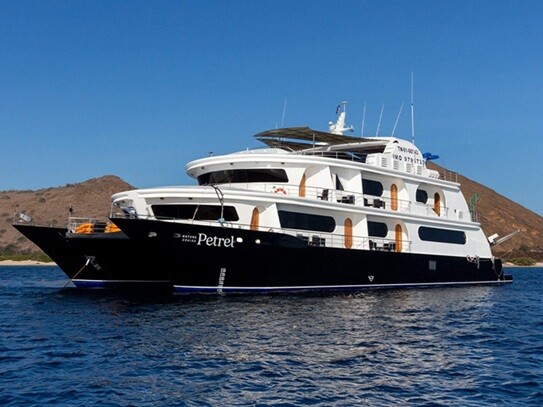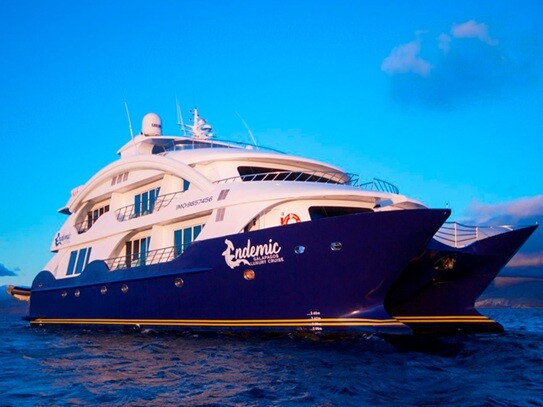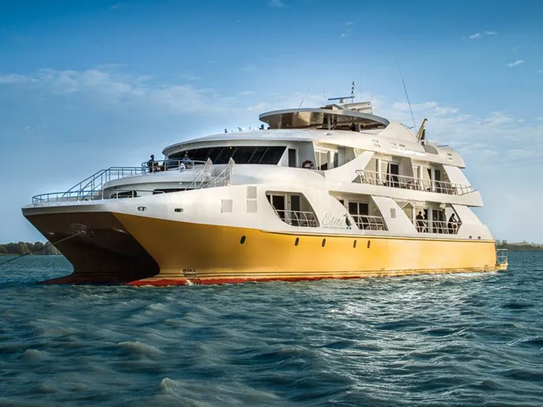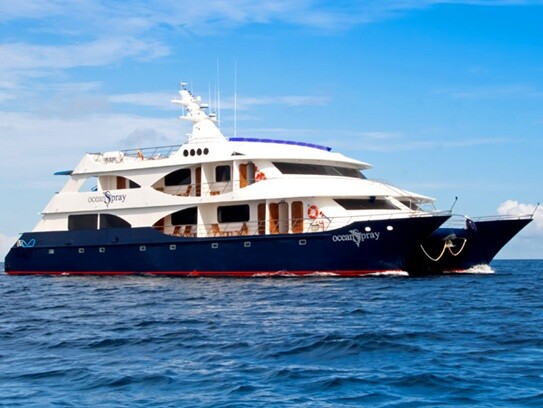- Specifications
- Trip Includes
- Trip Excludes
- Gallery
- FAQ
- Itinerary A (8D / 7N)
- Itinerary B (6D / 5N)
- Itinerary C (5D / 5N)
- Itinerary D (8D / 7N)
- Itinerary E (4D /3N)
- Itinerary F (6D /5N)
| Technical Details of Petrel | |
| Year of Construction | September 2015 |
| Type | Power Motor Catamaran |
| Length | 115 ft / 35 m |
| Beam | 41 ft / 12.5 m |
| Draft | 5.4 ft / 1.65 m |
| Tonnage | 208 tons |
| Capacity | 16 passengers |
| Accommodation | Main Deck: 2 Suites 463 ft² / 43 m², 2 Double Staterooms 323 ft² / 30 m² Upper Deck: 4 Double Staterooms 323 ft² / 30 m², 1 Single Stateroom 151 ft² / 14 m² *Cabin size includes balcony |
| Main Engines | 2 x Yanmar Diesel Engines 400HP @ 1950rpm |
| Power Generators | 2 x John Deere Genset 70kw @ 1800rpm |
| Cruising Speed | 10 knots |
| Water Maker | 2000 Gallons / day |
| Exterior | GFRP (Fiber Reinforced Polymer) |
| Crew | Captain, Bilingual Galapagos National Park Naturalist Guide, Cruise Manager, 8 other crew (First Mate, Second Mate, Chef, Sous Chef, Engineer, Assistant Engineer, Barman, Housekeeper) |
| Safety & Navigation | All equipment meets or exceeds SOLAS standards: 2x 20-man life rafts, Navtex, 2 GPS, Depth Sounder, 2 Naval Radars, Fire detection and prevention systems, etc. |
| Available Gear | Kayaks, Snorkeling Gear, Wet Suits |
Includes
| ✅ Scheduled visits and activities with a professional bilingual guide |
| ✅ All meals on board, some snacks, purified water, tea and coffee |
| ✅ Accommodation in a standard cabin with private bathroom and air conditioning |
| ✅ Snorkeling equipment (mask, lenses, fins), sea-kayaks |
| ✅ Assistance at the Airport and 24/7 during the trip |
Additional Information
- *Valid only during the operational dates of the cruise.
Excludes
| ❌ Air tickets to / from Galapagos from / to Quito, Guayaquil or combined route |
| ❌ Entrance to the Galapagos National Park US $ 200 p.p. (cash in the Islands) |
| ❌ Galapagos Control Card US $ 20 p.p. (at the airport before check-in) |
| ❌ Wet-suits rental on board (in cash) |
| ❌ Soft and alcoholic drinks on board; personal expenses, extras and tips guide and crew (cash) |
| ❌ Travel insurance with medical, cancellation and other unforeseen coverage |
| ❌ Other services in Continental Ecuador and not specified in the program |
Additional Information
- *Valid only during the operational dates of the cruise.
Monique is a modern catamaran designed for comfort and stability, offering spacious cabins, communal areas, and panoramic decks ideal for exploring the Galapagos Islands.
Monique can accommodate up to 16 guests, ensuring an intimate and personalized experience with attentive service.
The Monique visits several iconic islands including Santa Cruz, Isabela, Santiago, Rábida, and Fernandina, allowing guests to explore diverse landscapes and wildlife habitats.
Yes, all trips include expert naturalist guides who provide educational insights about the islands’ unique ecosystems, wildlife, and conservation efforts.
Monique offers comfortable cabins with private bathrooms, a lounge and dining area, sun deck, snorkeling equipment, and personalized service to ensure a memorable Galapagos experience.
| Day | Destination / Activity | Description |
|---|---|---|
| Day 1 | Baltra Island & North Seymour Island | North Seymour Island, formed by submarine lava, is home to ~2,500 land and blue-footed sea lions, common noddies, frigatebirds, blue-footed boobies, and iguanas. Spot marine and land iguanas along the coast, as well as the largest colony of Magnificent Frigatebirds. |
| Day 2 | Isabela Island: Vicente Roca Point & Fernandina Island: Espinoza Point | Vicente Roca Point: Unique geological formations, great for observing Nazca and blue-footed boobies. Activities include snorkeling, kayaking, or panga rides. Spot whales, dolphins, sea lions, and sometimes fur seals. Espinoza Point: Fernandina Island is untouched by foreign species. Lava fields reach the ocean, with La Cumbre volcano dominating. Cold Cromwell Current attracts Galapagos Penguins and Flightless Cormorants. |
| Day 3 | Isabela Island: Tagus Cove & Urbina Bay | Tagus Cove: Historic site with volcanic rocks inscribed by sailors. Trail leads to Darwin Lake via a tuff cone. Urbina Bay: Uplifted coral and reef due to tectonic activity. Possible sightings of giant tortoises and land iguanas near the coast. |
| Day 4 | Isabela Island: Elizabeth Bay & Moreno Point | Elizabeth Bay: Mangroves and islets attract many birds; sea turtles feed and rest in the lagoon. Moreno Point: Southwest tip of Isabela, with rare species and barren lava flows. Activities include hiking, panga rides, bird watching, and snorkeling. |
| Day 5 | Isabela Island: Sierra Negra Volcano, Wetlands & Breeding Center | Sierra Negra Volcano: Explore different vegetation zones, geological formations, and walk on lava flows. Easy access to Volcano Chico. Breeding Center: Isabela Breeding Center (Arnaldo Tupiza) breeds Galapagos Tortoises for release into the wild. |
| Day 6 | Santa Cruz Island: Charles Darwin Station & Twin Craters | Charles Darwin Station: Supports research and conservation programs including the Giant Tortoise Restoration Program. Assists researchers and Galapagos National Park. Twin Craters: Pair of volcanic craters formed from former magma chambers. Short hike through Scalesia forests provides excellent views. |
| Day 7 | South Plaza Island & Santa Fe Island | South Plaza Island: Compact but diverse flora; Sesuvium plants and prickly pear trees feed land iguanas. Mouse eradication boosted iguana population. Santa Fe Island: Home to Santa Fe land iguana and Opuntia Cactus. Landing beach features sea lions and Galapagos Hawks. Historically home to giant tortoises. |
| Day 8 | San Cristobal Island: Lobos Island & Departure | Lobos Island hosts nesting blue-footed boobies and frigatebirds, plus sea lions and marine iguanas. Views of Kicker Rock in the distance. Transfer to San Cristobal airport for departure to mainland Ecuador. |

| Day | Destination / Activity | Description |
|---|---|---|
| Day 1 | Santa Cruz Island: Twin Craters & Baltra Island | Arrival at Baltra Airport with transfer to M/C Petrel. Visit Twin Craters (Los Gemelos) with a short hike through Scalesia forests. Briefing on life aboard and cruise orientation. Santa Cruz Island is home to ~12,000 residents and features long paved roads. The Twin Craters were formed from collapsed magma chambers. |
| Day 2 | South Plaza Island & Santa Fe Island | South Plaza Island: Small island with rich flora and Sesuvium plants feeding land iguanas. Mouse eradication boosted iguana population. Santa Fe Island: Home to Opuntia Cactus and Santa Fe land iguana. See sea lions and Galapagos Hawks on the landing beach. Historically had giant tortoises. |
| Day 3 | San Cristobal Island: Interpretation Center & La Galapaguera | San Cristobal Island is the easternmost island and site of first permanent settlements. Visit La Galapaguera Interpretation Center, housing giant tortoises in a semi-natural habitat, with exhibits on history, ecosystems, and flora & fauna. Lobos Island nearby hosts nesting blue-footed boobies, frigatebirds, sea lions, and marine iguanas, with views of Kicker Rock. |
| Day 4 | Española Island: Gardner Bay & Suarez Point | Gardner Bay: White sandy beach with playful sea lions, green sea turtle nesting, and three species of finches. Friendly Española Mockingbirds may approach visitors. Suarez Point: Observe endemic species including Waved Albatross (breeding area), marine iguanas, Galapagos doves, blue-footed boobies, Nazca boobies, and Darwin finches. Scenic landscape with endemic wildlife. |
| Day 5 | Floreana Island: Cormorant Point, Devil’s Crown & Post Office Bay | Cormorant Point: Two contrasting beaches: green (olivine) and white coral “Flour Beach”; flamingos in brackish lagoons. Devil’s Crown: Snorkeling site with submerged volcanic structures, colorful fish, sharks, sea lions, and turtles. Post Office Bay: Historic whalers’ post office; visitors leave postcards for future visitors. Baroness Lookout Point: Historic viewpoint with scenic landscapes and interesting local history. |
| Day 6 | Santa Cruz Island: Charles Darwin Station & Departure | Visit Charles Darwin Research Station, involved in conservation and research, including the Giant Tortoise Restoration Program. Cruise ends with transfer to Baltra Airport for departure to mainland Ecuador. |

| Day | Destination / Activity | Description |
|---|---|---|
| Day 1 | Santa Cruz Island: Highlands | Arrival at Santa Cruz Island. Explore the Highlands, featuring rich wildlife, hills, ferns, volcanoes, and lava tube formations. Observe agricultural zones from a viewpoint and enjoy birdwatching. After the visit, transfer to the yacht and settle into your cabin before the briefing. |
| Day 2 | Santiago Island: Sullivan Bay & Bartolome Island | Sullivan Bay: Satellite island of Santiago; ideal for viewing Galapagos fur seals and unique lava formations including tuff cones and pyroclastic cones. Bartolome Island: Famous for Pinnacle Rock, formed from magma cooled by seawater. Observe nesting green sea turtles, Galapagos penguins, colorful fish, and sea lions. Pinnacle Rock is one of the most photographed locations in the Galapagos. |
| Day 3 | Genovesa Island: Darwin Bay & El Barranco | Darwin Bay: Horseshoe-shaped island formed by shield volcano; home to over 200,000 red-footed boobies and unique marine iguanas. El Barranco (Prince Philip's Steps): Steep cliff path with Palo Santo forest; observe nesting red-footed boobies and other endemic birds with spectacular panoramic views. |
| Day 4 | Santiago Island: Egas Port & Espumilla Beach | Egas Port (James Bay): Spot lava lizards, Galapagos fur seals, and enjoy snorkeling. Buccaneer Cove: Excellent snorkeling site with rich marine life and underwater formations; historically a refuge for pirates. Espumilla Beach: Observe marine iguanas and Sally-Lightfoot crabs; snorkel with tropical fish, octopus, and moray eels. |
| Day 5 | Santa Cruz Island: Carrion Point & Departure | Carrion Point, located on the northern coast at Itabaca Channel's entrance, offers turquoise waters ideal for snorkeling or panga rides. Cruise concludes with transfer to Baltra Airport for departure to mainland Ecuador. |

| Day | Destination / Activity | Description |
|---|---|---|
| Day 1 | San Cristobal Island: Interpretation Center & La Galapaguera | Visit La Galapaguera, an interpretation center open since 1998, with exhibits on Galapagos history, ecosystems, geology, and flora & fauna. Observe giant tortoises in a semi-natural habitat. Optionally visit Lobos Island to see blue-footed boobies, frigate birds, sea lions, and marine iguanas with views of Kicker Rock. |
| Day 2 | Española Island: Gardner Bay, Gardner Islet & Suarez Point | Gardner Bay: White sandy beach with playful sea lions, green sea turtle nesting (Jan–Mar), and various finches and mockingbirds. Suarez Point: Endemic species, Waved Albatross breeding area, marine iguanas, Galapagos doves, blue-footed boobies, Nazca boobies, Darwin finches, and other tropical birds. |
| Day 3 | Floreana Island: Cormorant Point, Devil’s Crown & Post Office Bay | Cormorant Point: Two beaches with green olivine sand and white Flour Beach; flamingos in brackish lagoons. Devil’s Crown: Top snorkeling site with colorful fish, sharks, sea turtles, and hammerhead sharks. Post Office Bay: Historical whaler post office from 1797; visitors leave and pick up postcards. Optional visit to Baroness Lookout Point for historic views. |
| Day 4 | Santa Cruz Island: Charles Darwin Station & Highlands | Charles Darwin Station: Research and conservation station; Giant Tortoise Restoration Program covering eggs, hatchlings, and adults. Highlands: Explore lava tubes, view agricultural zones, enjoy rich birdwatching and diverse wildlife, hills, ferns, and volcanic landscapes. |
| Day 5 | Santiago Island: Sullivan Bay & Bartolome Island | Sullivan Bay: Observe Galapagos fur-seals and unique lava formations including tuff cones. Bartolome Island: Pinnacle Rock, a result of underwater volcanic activity; green sea turtles nesting, Galapagos penguins, colorful fish, and sea lions. Famous photography location featured in "Master and Commander". |
| Day 6 | Genovesa Island: Darwin Bay & El Barranco | Darwin Bay: Horseshoe-shaped island, home to over 200,000 red-footed boobies and marine iguanas. El Barranco (Prince Philip's Steps): Steep path with spectacular cliff views; Palo Santo forest with nesting red-footed boobies and other endemic birds. |
| Day 7 | Santiago Island: Egas Port, Buccaneer Cove & Espumilla Beach | Egas Port (James Bay): Galapagos lava lizards, fur seals, and snorkeling. Buccaneer Cove: Former pirate refuge with excellent snorkeling and abundant fish. Espumilla Beach: Marine iguanas, Sally-Lightfoot crabs, snorkeling with octopus, moray eels, and tropical fish. |
| Day 8 | Santa Cruz Island: Carrion Point & Departure | Carrion Point at the Itabaca Channel's entrance; snorkeling or panga ride in turquoise waters and protected lagoon. Cruise concludes with transfer to Baltra Airport for departure to mainland Ecuador. |

| Day | Destination / Activity | Description | Meals Included |
|---|---|---|---|
| Day 1 | San Cristobal Island: La Galapaguera | Arrive at Galapagos National Park, clear customs and transit control. Meet the naturalist guide and transfer to the M/C Petrel. Safety briefing and cabin assignment. Visit La Galapaguera to observe Galapagos tortoises at all stages, from eggs and hatchlings to adults. Dry landing; wear comfortable walking shoes. Explore conservation efforts and the history of Galapagos tortoise protection. | Lunch, Dinner |
| Day 2 | Española Island: Gardner Bay & Suarez Point | Gardner Bay: Dry landing; activities include short hike, snorkeling, kayaking, and panga ride. White sandy beach, marine iguanas, and sea lions. Explore Osborn Islet with marine birds and snorkeling opportunities. Suarez Point: Dry landing; hiking. Observe marine iguanas, blowhole formations, and the waved albatross, the only breeding site of this species in the world. Courtship dance of albatross during mating season is visible. | Breakfast, Lunch, Dinner |
| Day 3 | Floreana Island: Cormorant Point, Devil’s Crown & Post Office Bay | Cormorant Point: Wet landing; hike and panga ride. Visit green olivine beach and saltwater lagoon with bright pink flamingos. Devil’s Crown: Wet landing; snorkeling. Explore unique underwater world with corals, seahorses, rays, and colorful fish. Post Office Bay: Wet landing; hike. Participate in the traditional post office barrel to leave or pick up letters and postcards. Learn about the island's human history and colonization. | Breakfast, Lunch, Dinner |
| Day 4 | Santa Cruz Island: Charles Darwin Station & Departure via Baltra Island | Visit Charles Darwin Research Station, see Galapagos tortoises at all stages of development. Learn about conservation programs. Transfer to Baltra Airport with guide assistance for check-out and departure. Show transit control card at airport security. | Breakfast |

| Day | Destination / Activity | Description | Meals Included |
|---|---|---|---|
| Day 1 | Baltra Island & North Seymour Island | North Seymour Island: Named after Lord Hugh Seymour. Formed by submarine lava uplift. Home to ~2,500 land and blue-footed sea lions, common noddies, frigatebirds, blue-footed boobies, and marine and land iguanas. Largest colony of Magnificent Frigatebirds. Observe wildlife along the coast and enjoy dry landing exploration. | Not specified |
| Day 2 | Isabela Island: Vicente Roca Point & Fernandina Island: Espinoza Point | Vicente Roca Point: Remarkable geological formations. Observe Nazca and blue-footed boobies. Snorkeling, dinghy, panga, or kayak activities. Spot whales, dolphins, sea lions, and sometimes fur seals. Espinoza Point: Fernandina Island, westernmost island, pristine ecosystem with lava fields. Volcano "La Cumbre" dominates landscape. Home to Galapagos Penguins and Flightless Cormorants. Cromwell Current brings nutrients to the area. | Not specified |
| Day 3 | Isabela Island: Tagus Cove & Urbina Bay | Tagus Cove: Named after English warship. Volcanic rocks with inscriptions. Trail leads to Darwin Lake via a tuff cone. Urbina Bay: Volcanic and tectonic uplift site. Corals and reefs raised above sea level. Possible sightings of giant tortoises and land iguanas near the coast. | Not specified |
| Day 4 | Isabela Island: Elizabeth Bay & Moreno Point | Elizabeth Bay: Surrounded by mangroves and islets. Ideal for birdwatching and spotting sea turtles. Moreno Point: Southwest tip of Isabela Island. Home to rare species on barren lava flows. Activities include hiking, panga rides, seabird watching, and snorkeling. | Not specified |
| Day 5 | Isabela Island: Sierra Negra Volcano & Breeding Center | Sierra Negra Volcano: Two oldest volcanoes in the south of Isabela. Explore vegetation zones, geological formations, and caldera. Option to walk on lava flows and visit Volcano Chico. Breeding Center: Isabela Breeding Center, named after Arnaldo Tupiza. Galapagos Tortoises are bred here to be released into the wild. | Not specified |
| Day 6 | Santa Cruz Island: Charles Darwin Station & Departure | Santa Cruz Island: ~12,000 residents, longest paved road in Galapagos. Focus on conservation of native species. Charles Darwin Research Station: Involved in research and education. Observe all stages of Galapagos tortoise life. Cruise ends with transfer to Baltra Airport for departure to mainland Ecuador. | Not specified |








































